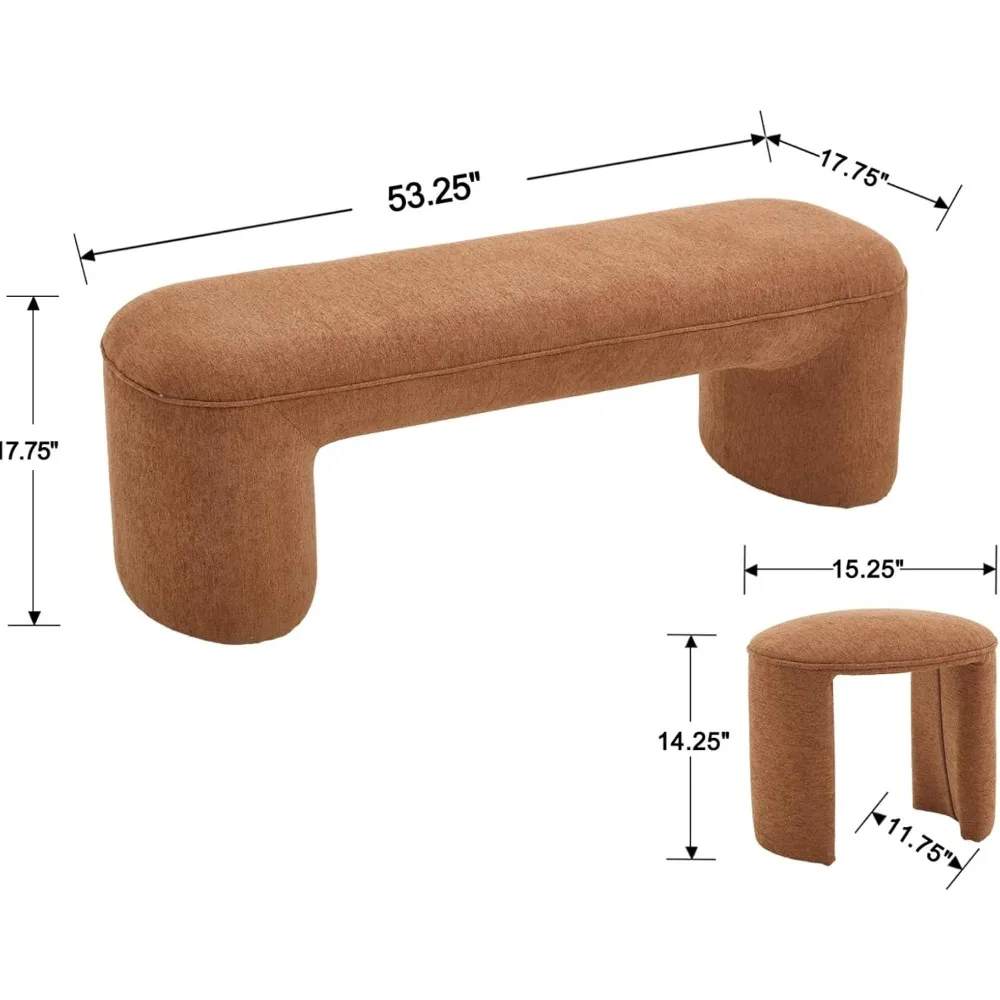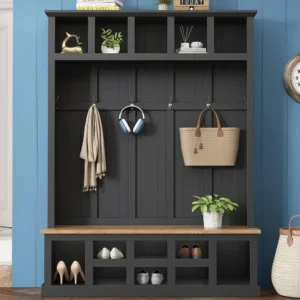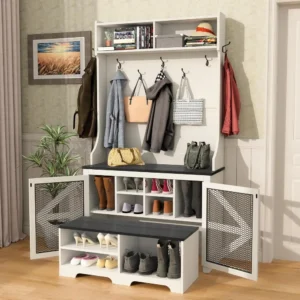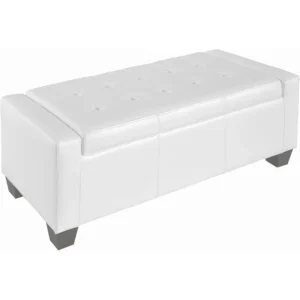Understanding the Entryway Challenge for Families
The typical family entryway often resembles a storm zone rather than the welcoming threshold to your home. Shoes scattered in every direction, coats dropped haphazardly on the floor, backpacks piled in corners, and sports equipment creating obstacle courses – sound familiar? This daily chaos isn’t just unsightly; it creates real challenges for family functioning.
Families face unique entryway organizational hurdles that single-person households simply don’t encounter:
- Multiple people entering and exiting at different times
- Varying storage needs across age groups
- Seasonal gear multiplication (one person’s winter gear is manageable; five sets become overwhelming)
- School supplies, sports equipment, and other child-specific items
- Limited patience (especially among younger family members) for complex organizational systems
The impact of this disorganization extends beyond mere aesthetics. Morning rushes become frantic searches for missing shoes or homework. After-school arrivals result in dropped items that create tripping hazards. Winter brings the additional challenge of wet boots, dripping coats, and countless accessories that seem to vanish into thin air.
Children’s items present special challenges – smaller sizes requiring different storage solutions, more frequent misplacement, and the need for systems simple enough for little ones to follow independently. However, with thoughtful space-saving solutions for entryways, this high-traffic area can be transformed from chaotic to calm.
Benefits of Well-Organized Family Entryway Storage
Creating an organized entryway delivers tangible benefits that improve daily family life in numerous ways:
Streamlined morning routines: When everyone knows exactly where to find their belongings, mornings become less stressful and more efficient. No more frantic searches for missing gloves or backpacks when the bus is minutes away.
Reduced family stress: Eliminating the constant “I can’t find my…” moments decreases household tension and arguments.
Teaching responsibility: Well-organized spaces with designated spots for each family member help children learn to take ownership of their belongings.
Positive first impression: A tidy, organized entryway welcomes guests with a sense of calm rather than chaos.
Home protection: Proper storage for wet or dirty items prevents damage to flooring, furniture, and walls.
Enhanced comfort: Coming home feels more welcoming when you’re not greeted by clutter and disorder.
When families implement effective storage systems, the impact is immediate. Children quickly adapt to knowing exactly where their backpack belongs after school. Parents spend less time hunting for car keys or searching for matching gloves. The entire household benefits from strategies for organizing entryways that make transitions smoother and less stressful.
Assessing Your Family’s Entryway Needs
Before rushing to purchase storage solutions, take time to thoroughly assess your family’s unique needs. This thoughtful evaluation will ensure you invest in systems that actually work for your household.
Who uses the space?
The number of family members and their ages significantly impact your storage requirements. A household with teenagers needs different solutions than one with toddlers. How many people need dedicated storage? Do you need child-height options?
What items need to be stored?
Make a comprehensive list of everything that regularly passes through your entryway. Consider seasonal variations – winter coats and boots require more space than summer sandals and light jackets. Don’t forget sports equipment, school supplies, pet items, and accessories.
How much physical space is available?
Measure your entryway carefully, noting the dimensions and any architectural features that might limit or enhance storage options. Small spaces require more creative organization solutions for limited entryways.
What’s your typical entry/exit routine?
Does everyone leave at once in the morning or are departures staggered? Do you enter through the same door you exit? Understanding traffic patterns helps determine the most efficient storage configuration.
What are your aesthetic preferences?
Your entryway makes the first impression of your home. What style elements are important to you? Do you prefer hidden storage or are you comfortable with open systems?
What’s your budget range?
Storage solutions come at all price points. Determining your budget helps narrow options and may influence whether you choose ready-made furniture or DIY alternatives.
Involving the whole family in this planning process increases buy-in and helps ensure the systems you implement will actually be used by everyone.
Essential Furniture Solutions for Family Entryways
Entryway Benches with Storage
A well-designed storage bench serves as the cornerstone of many family entryway systems, offering multiple functions in one piece. The seating area provides a comfortable place for putting on and removing shoes – especially helpful for younger children still mastering these skills.
Storage benches come in several configurations, each offering unique benefits:
- Cubbies beneath the seat: Perfect for shoe storage with easy visibility and access
- Drawers: Ideal for containing smaller items like gloves, hats, and scarves
- Lift-top designs: Offer concealed storage for items you want hidden from view
When selecting the right entryway bench with storage for your family, consider size carefully. A bench accommodating two adults might be insufficient for a family of five. Generally, allow 18-24 inches (45-60 cm) of seating width per person for comfortable use.
Material selection becomes crucial for family durability. Look for:
– Solid wood construction for long-term stability
– Easy-clean fabrics for cushioned seats
– Scratch-resistant finishes that withstand daily use
Style-wise, choose a bench that complements your home décor while meeting functional needs. A farmhouse-style bench with open cubbies works beautifully in traditional homes, while a sleek, modern design with hidden storage might better suit contemporary spaces.
Cubbies and Lockers: Individual Storage Spaces
Personalized storage spaces solve one of the biggest challenges in family organization: keeping each person’s belongings separate and accessible. Mudroom bench cubbies and locker systems provide dedicated zones that minimize morning confusion and teach children organizational skills.
Benefits of individual storage include:
– Eliminating arguments over whose items are whose
– Creating accountability for personal belongings
– Streamlining morning departures when items are consistently stored
– Accommodating the specific needs of different family members
Cubby and locker systems come in various configurations:
– Open cubbies for easy access but visible contents
– Closed lockers for concealed storage and a tidier appearance
– Combination systems featuring both open and closed components
– Adjustable shelving that adapts as storage needs change
Personalizing these spaces enhances functionality. Consider adding:
– Name labels (or picture labels for non-readers)
– Color-coded elements to distinguish each person’s area
– Different interior configurations based on individual needs
Quality cubby systems should feature sturdy construction, smooth-gliding doors or drawers if included, and adaptable components that accommodate growing children’s changing storage needs.
Hall Trees: All-in-One Entryway Solutions
For families seeking comprehensive organization in a single piece of furniture, entryway hall trees offer remarkable efficiency. These multi-functional pieces typically combine seating, coat hooks, and shelving in a vertical design that maximizes space utility.
The space-saving benefits of hall trees make them ideal for modest entryways where multiple separate pieces wouldn’t fit. By building upward rather than outward, they deliver substantial storage without consuming precious floor area.
Modern hall trees range from traditional coat rack designs with built-in benches to contemporary units with closed cabinets, mirrors, and specialized compartments. Materials vary from classic solid wood construction to industrial metal-wood combinations that suit modern farmhouse or urban aesthetics.
When selecting a family-friendly hall tree, look for:
– Sturdy construction that can withstand daily use
– Hooks positioned at appropriate heights for both adults and children
– Adequate seating for practical use when putting on shoes
– Secure mounting options if the unit is tall or top-heavy
Most hall trees require some assembly, but the unified storage solution they provide makes this effort worthwhile for many busy households.
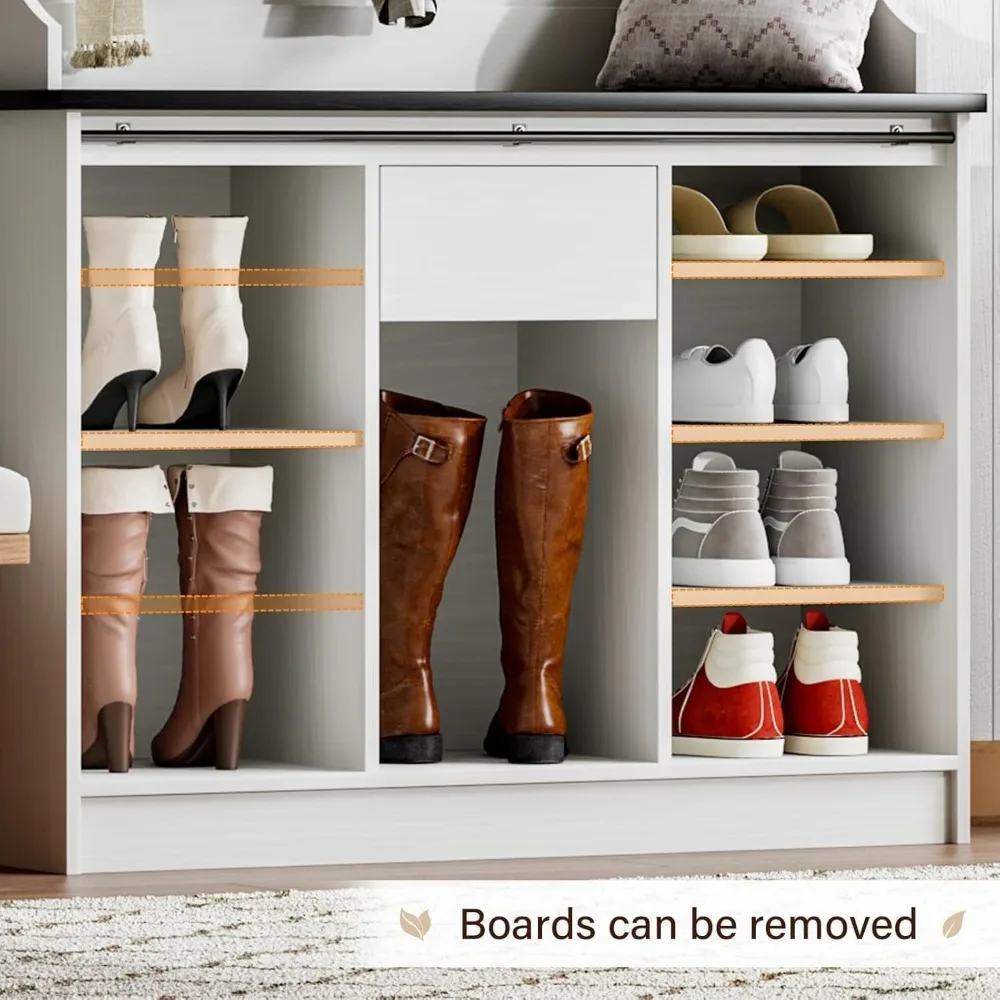
Space-Saving Solutions for Compact Entryways
Not every home enjoys a spacious foyer or dedicated mudroom. Many families must maximize organization within limited square footage. Fortunately, numerous space-saving entryway ideas can transform even the tightest spaces into functional entry zones.
Narrow console tables provide surface space without protruding too far into walkways. Look for designs with storage drawers or shelves beneath. Tables less than 10 inches (25 cm) deep can work in even the slimmest corridors while still providing valuable storage.
Wall-mounted solutions free up floor space entirely. Consider:
– Floating shelves with hooks underneath
– Fold-down desks that double as mail sorting stations
– Wall-mounted cabinets that project minimally into the room
Corner units utilize often-overlooked spaces, turning awkward angles into organizational assets. L-shaped benches or triangular shelving units fit snugly into corners that would otherwise remain unused.
Multi-functional pieces deliver maximum value in minimal space. Look for:
– Mirrors with hidden storage behind them
– Benches that slide under console tables when not in use
– Nesting tables that can be expanded when needed
Vertical storage maximizes cubic footage rather than square footage. Tall, slim cabinets and floor-to-ceiling hook systems utilize height effectively when floor space is limited.
Maximizing Vertical Storage in Family Entryways
Wall-Mounted Hooks and Racks Systems
Vertical wall space represents prime organizational real estate that many families underutilize. Bench and hook storage systems effectively capture this vertical opportunity while keeping frequently used items visible and accessible.
When installing hooks for family use, height consideration becomes crucial:
– Adult coat hooks: 60-66 inches (150-168 cm) from the floor
– Children’s hooks: 30-48 inches (75-120 cm) from the floor, depending on age
– Backpack hooks: Positioned at appropriate heights for respective users
Hook systems come in various styles to match both functional needs and aesthetic preferences:
– Decorative individual hooks for lighter items
– Industrial-strength utility hooks for heavy bags and sports equipment
– Adjustable rail systems that can be reconfigured as family needs change
For families with children, consider weight capacity carefully. A hook that adequately supports an adult coat may fail under the weight of a backpack loaded with textbooks. Look for hooks rated for at least 25-35 pounds (11-16 kg) for general family use.
Creative arrangements can transform functional hooks into design features. Consider:
– Staggered heights creating visual interest
– Combination of hook styles for different purposes
– Color-coordinated hooks corresponding to family members
Secure installation is non-negotiable. Always mount hooks into studs or use appropriate wall anchors rated for the expected weight plus a safety margin.
Shelving Solutions for Entryways
Strategic shelving adds valuable storage while contributing to your entryway’s aesthetic appeal. Different shelving styles suit different family needs:
- Floating shelves create a sleek, modern look while providing surfaces for both practical items and decorative elements
- Bracketed shelves support heavier loads and often accommodate baskets or bins
- Built-in shelving offers customized solutions integrated with surrounding architecture
When families incorporate shelving, safety considerations become paramount, especially with young children. Secure all shelving appropriately for its weight capacity, and position heavy items on lower shelves to prevent tipping hazards.
Shelves work best for items you want visible and accessible:
– Frequently used items on middle shelves
– Decorative elements or seasonal displays on upper shelves
– Baskets containing small items like gloves or sunscreen
Combining shelves with other storage elements creates comprehensive systems – shelves above bench seating, shelving flanked by hooks, or shelves integrated into cubby systems.
For family use, consider shelf depth carefully. Standard 10-12 inch (25-30 cm) shelves accommodate most items, but consider deeper options if you’ll be storing larger baskets or bulkier items.
Organizational Accessories for Family Entryways
Baskets, Bins, and Containers
Containment solutions transform cluttered chaos into organized, accessible storage. Baskets, bins and containers keep small items corralled while adding style to your entryway.
The benefits of contained storage extend beyond mere organization:
– Small items stay together rather than scattering
– Contents can be quickly moved if needed (like clearing space for guests)
– Visual clutter disappears, even when items are plentiful
– Seasonal rotation becomes simpler when items are grouped
Material selection should reflect both your aesthetic preferences and practical considerations:
– Fabric bins offer softness and often fold flat when not needed
– Plastic containers provide durability and easy cleaning for messy items
– Woven baskets bring natural texture but may be less easy to clean
– Wire baskets allow visibility of contents while maintaining containment
Labeling transforms good storage into great storage, especially for families. Consider:
– Traditional labels for older children and adults
– Picture labels for non-readers
– Color-coding that corresponds to family members
Size appropriateness matters significantly. Measure shelves and cubby spaces before purchasing, and consider the typical volume of items to be stored. Multiple medium containers often work better than single large ones, allowing for more specific organization.
Shoe Storage Solutions for Families
Footwear presents one of the greatest organizational challenges for family entryways. The sheer volume of shoes – from tiny toddler sneakers to adult work shoes and seasonal variations – requires thoughtful systems.
Shoe storage benches offer the perfect combination of seating and organization, allowing family members to sit comfortably while removing or putting on shoes. Look for designs with divided compartments to keep pairs together.
Beyond benches, consider these shoe storage options:
– Open racks for frequently worn shoes (typical capacity: 9-12 adult pairs per 3-tier rack)
– Cabinets with doors for a cleaner appearance
– Over-door hanging organizers for maximizing closet space
– Boot trays for wet or muddy footwear
For busy families, implementing a rotational system often works best. Keep in-season, frequently-worn shoes in primary storage, with off-season or special occasion footwear stored elsewhere. This prevents entryway shoe storage from becoming overwhelmed.
Teaching children to maintain shoe organization requires systems simple enough for them to use independently:
– Clear designations for where shoes belong
– Easy-access storage without complicated mechanisms
– Regular family “reset” times to reorganize
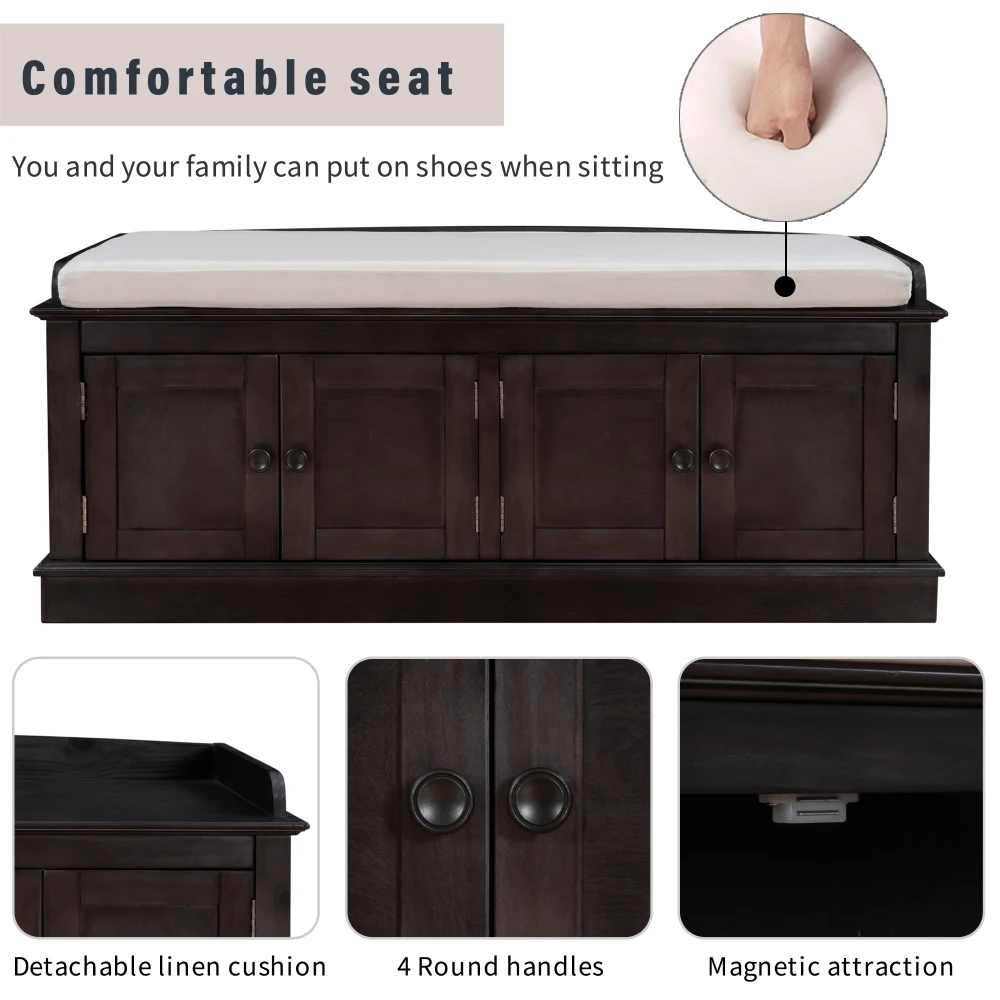
Small Item Organization for Keys, Mail, and Devices
Small items often create the most frustrating entryway clutter. Keys disappear, mail piles up, and devices get misplaced during the coming-and-going shuffle. Creating designated “drop zones” prevents these common frustrations.
Wall-mounted organizers near the door provide immediate destinations for mail, preventing it from spreading across counters or tables. Look for designs with sorting categories to separate bills, catalogs, and personal correspondence.
Key management becomes simple with dedicated solutions:
– Decorative key hooks mounted near the door
– Magnetic key holders requiring minimal space
– Key boxes with combination locks for secure storage
Charging stations keep devices organized and powered. Models designed specifically for entryways often feature:
– Multiple charging ports
– Cord management
– Shelf space for holding devices while charging
Small decorative bowls or trays corral loose items like sunglasses, transit cards, or pocket change. Position these on entryway surfaces where family members naturally set down small items.
For children’s small treasures – from rocks to tiny toys – consider special containers at their height. These designated spaces prevent small items from becoming scattered while respecting children’s desire to keep special finds.
Creating Kid-Friendly Entryway Systems
Successful family organization requires systems that work for the youngest household members. Age-appropriate solutions consider children’s developing abilities and changing needs.
For toddlers and preschoolers:
– Low hooks they can reach independently
– Simple, open storage without complex closures
– Picture labels for non-readers
– Fewer choices to prevent overwhelming options
For elementary-aged children:
– Combination of open and closed storage
– Basic written labels with pictures
– Defined spaces for school items
– Hook heights adjusted to their growth
For teens:
– More sophisticated storage matching their style preferences
– Space for electronic devices and chargers
– Room for larger sports equipment
– Privacy options for personal items
Visual systems work exceptionally well for helping children develop organization habits:
– Color-coding by family member
– Picture labels showing exactly what belongs where
– Clear containers allowing contents to be seen
Teaching organizational routines proves as important as the physical systems themselves. Establishing simple procedures – shoes go here, backpack goes there, coat on this hook – creates habits that eventually become automatic.
As children grow, storage needs evolve dramatically. Mudroom bench layouts for families that incorporate adjustable components accommodate these changes without requiring complete system replacement.
Safety considerations should influence all family entryway decisions. Secure furniture to walls if there’s any tip risk, avoid sharp corners at eye level for small children, and ensure storage units won’t collapse if climbed upon (because they will be tested!).
Seasonal Adaptations for Family Entryway Storage
Entryway storage needs fluctuate dramatically throughout the year. Implementing seasonal rotation prevents systems from becoming overwhelmed during heavy-use periods.
Winter presents unique challenges with bulky coats, multiple accessories, and wet footwear. Consider:
– Boot trays with water-resistant materials
– Extra hooks for scarves and heavier coats
– Dedicated basket for gloves, hats and ear warmers
– Umbrella stand with drip tray
Summer brings its own storage requirements:
– Sunscreen and bug spray containers
– Sports equipment organization
– Swim bag storage
– Hat and sunglasses stations
Transitional seasons often create the greatest challenges as families need both warm and cool weather items accessible. During these periods, implement:
– Front-facing storage for current season items
– Secondary, less accessible storage for off-season items
– Weekly evaluations of what’s still needed vs. what can be stored
The ideal time for seasonal rotation falls about two weeks before weather typically changes. This provides buffer time while preventing systems from being cluttered with unnecessary items.
Off-season gear should move to secondary storage – basement, garage, or closets – clearly labeled for easy retrieval when needed again. Vacuum-sealed bags work well for compressing bulky winter items during summer months.
Family Command Centers: Extending Entryway Functionality
Beyond physical item storage, many families benefit from incorporating information management into their entryway organization. A family command center centralizes communication and keeps important information accessible to everyone.
Effective command centers typically include:
– Family calendar showing everyone’s schedules
– Mail sorting system with action categories (to pay, to respond, to file)
– Message board for family communications
– File system for school papers and important documents
– Charging station for family devices
When integrating a command center with entryway storage, consider:
– Visual harmony between organizational elements
– Appropriate height for different family members
– Adequate lighting for reading documents
– Protection from entryway moisture and temperature fluctuations
Digital alternatives increasingly supplement or replace traditional paper systems:
– Shared family calendar apps
– Digital photo frames displaying schedules
– Voice assistants for reminders and information
– Family communication apps
Whether analog or digital, the most successful command centers remain simple enough for all family members to use consistently. Overly complex systems, regardless of their theoretical effectiveness, ultimately fail through disuse.
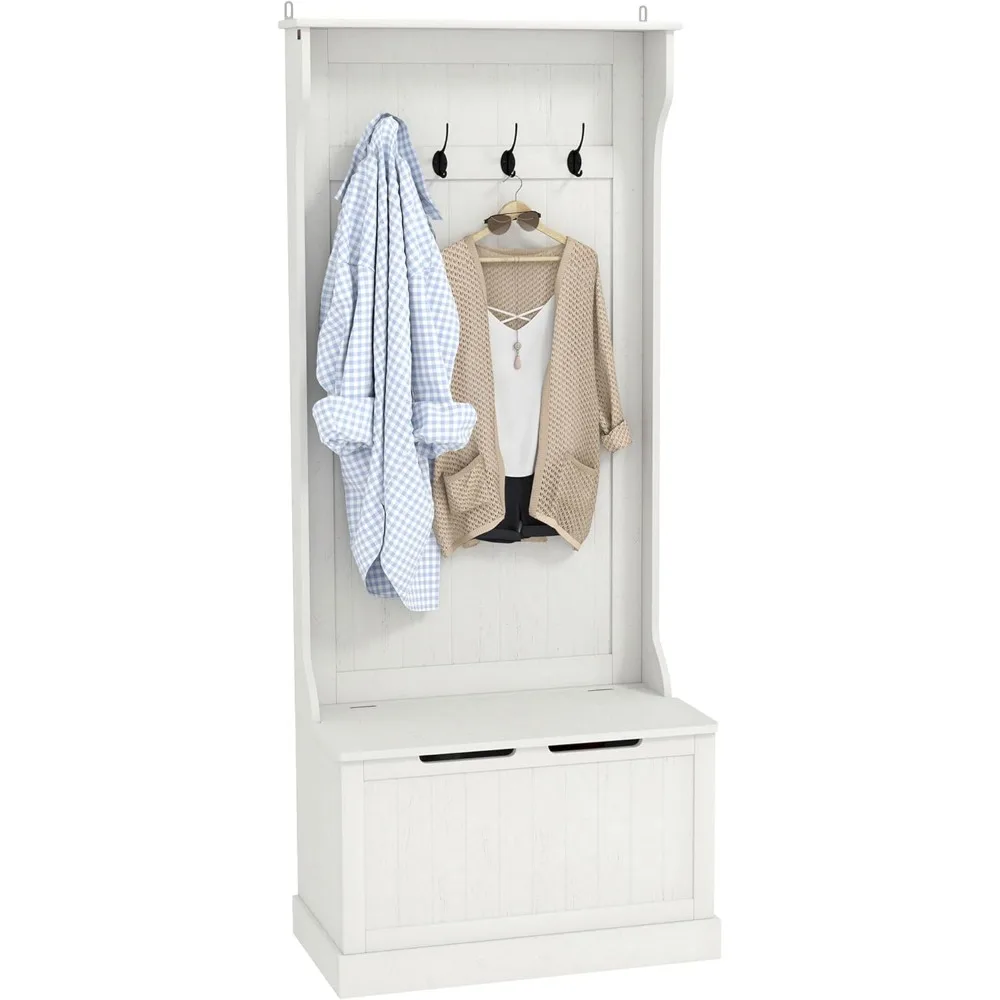
Shoe Storage Bench for Entryway
$459.02 Select options This product has multiple variants. The options may be chosen on the product pageBench with Hooks and Storage, Entryway Hall Tree, Mudroom Bench with Cubbies, Mudroom Bench with Shoe Storage
$818.38 Select options This product has multiple variants. The options may be chosen on the product pageEntryway Coat Rack Bench, Entryway Hall Tree, Farmhouse Mudroom Bench, Mudroom Bench with Shoe Storage
$805.09 Select options This product has multiple variants. The options may be chosen on the product pageBench with Hooks and Storage, Entryway Coat Rack Bench, Entryway Hall Tree, Mudroom Bench with Shoe Storage, Mudroom Coat Rack Bench
$793.73 Select options This product has multiple variants. The options may be chosen on the product pageCoat Rack Shoe Bench, Entryway Coat Rack Bench, Entryway Hall Tree, Wood Entryway Bench
$479.82 Select options This product has multiple variants. The options may be chosen on the product pageEntryway Bench with Storage, Shoe Bench for Entryway
$487.70 Select options This product has multiple variants. The options may be chosen on the product page
The right storage solutions for active households combine durability with thoughtful design features that accommodate busy family lifestyles. Look for pieces that can withstand daily use while maintaining their appearance and functionality.
Maintaining an Organized Family Entryway
Even the most brilliantly designed storage system requires maintenance. For busy families, incorporating simple routines prevents organizational regression.
Daily quick-tidy routines prevent accumulation:
– 5-minute reset before bedtime
– “One in, one out” rule for coats and shoes
– Everything returned to designated locations
– Quick sweep or vacuum of entryway floor
Weekly maintenance preserves system functionality:
– Wiping down surfaces that collect dust
– Returning misplaced items to proper locations
– Checking for items that need washing or repair
– Removing items that don’t belong in the entryway
Seasonal deep organization provides opportunity for system evaluation:
– Purging outgrown or unused items
– Cleaning storage furniture thoroughly
– Reassessing if current systems still meet family needs
– Repairing any damaged components
Involving children in maintenance builds lifelong organizational skills. Assign age-appropriate tasks:
– Toddlers: Putting their own shoes in designated spots
– Elementary children: Hanging up their coats and backpacks
– Teens: Taking responsibility for their sports equipment and electronics
Watch for problem areas that consistently accumulate clutter – these indicate system weaknesses that may need redesigning. Perhaps hooks are too high for children, or the shoe rack is difficult to access.
As family circumstances change – new activities, growing children, different schedules – be prepared to adapt your entryway systems. The best small benches for entryways might need upgrading as children grow and require more storage space.
Frequently Asked Questions About Family Entryway Storage
How can I create entryway storage on a tight budget?
Start with affordable basics like wall-mounted hooks and shoe racks. Repurpose furniture you already own – a small bookshelf can become cubby storage with added baskets. Look for secondhand furniture that can be refreshed with paint. Implement the organizational systems first; you can upgrade to more aesthetic pieces over time.
What are the most durable materials for family entryway furniture?
Solid wood construction typically offers the best durability for family use. Look for hardwoods like oak, maple, or birch rather than softer woods or particle board. For upholstered pieces, performance fabrics designed for high traffic and stain resistance will maintain their appearance longer. Metal components should be powder-coated or treated to prevent rust from wet items.
How do I handle wet or muddy items in the entryway?
Designate a specific zone for wet items, ideally with water-resistant flooring. Use boot trays with raised edges to contain moisture and prevent damage to surrounding areas. Install hooks specifically for wet items, separate from dry storage. Consider a small rack where items can air dry before being put away properly.
How can I organize multiple children’s items without confusion?
Color-coding provides the simplest differentiation – assign each child a color for their hooks, bins, and other storage elements. For non-readers, picture labels help identify where items belong. Creating equal, defined spaces for each child prevents disputes over territory and clarifies expectations.
What’s the best way to handle seasonal gear transitions?
Implement a gradual transition rather than a complete swap. As seasons change, move the most frequently needed items to prime storage positions while gradually shifting off-season items to secondary storage. Keep a small supply of off-season emergency items accessible (like a few winter hats during summer for unexpected weather).
How can I make our tiny entryway work for our large family?
Maximize vertical space with floor-to-ceiling storage solutions. Consider behind-door storage options and wall-mounted systems that don’t consume floor space. Implement strict rotation policies – only current season items in the main entryway. Create secondary drop zones elsewhere in your home for less frequently used items. Use multi-functional furniture like storage benches that serve dual purposes.

